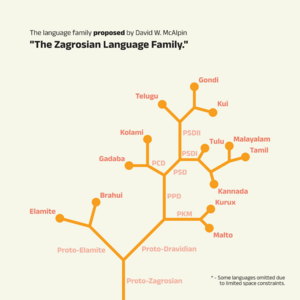Elamo-Dravidian languages facts for kids
Quick facts for kids Elamo-Dravidian |
|
|---|---|
| Zagrosian | |
| Geographic distribution: |
South Asia, West Asia |
| Linguistic classification: | Proposed language family |
| Subdivisions: | |
| Top - 0-9 A B C D E F G H I J K L M N O P Q R S T U V W X Y Z |
The Elamo-Dravidian language family is a proposed idea that connects two groups of languages. It links the Elamite language from ancient Elam (now parts of Iran and Iraq) to the Dravidian languages spoken in South Asia.
A linguist named David W. McAlpin is a main supporter of this idea. Another major supporter is Franklin Southworth. This hypothesis has been discussed by experts. However, many linguists have also criticized it. It remains just one of several ideas about where Dravidian languages came from. Most scholars believe Elamite is a language isolate. This means it is not related to any other known language.
What is the Elamo-Dravidian Hypothesis?
This idea suggests that the Elamite and Dravidian languages might share a common ancestor. This would mean they both came from an older, single language. The latest version of this idea (from 2015) suggests that the Brahui language is more closely related to Elamite than to other Dravidian languages. Brahui is a Dravidian language spoken in parts of Pakistan.
History of the Idea
The thought that Elamite and Dravidian might be connected goes back a long time. It started in the early 1800s. Edwin Norris was the first to write about this idea in 1853.
Later, Robert Caldwell added more evidence in 1856. He published a book about how Dravidian languages compare to each other. David McAlpin, a professor of Dravidian languages, published many papers supporting this theory. He also wondered if the language of the Indus Valley civilization (called the Harappan language) might also be part of this family.
Linguistic Clues
David McAlpin believes that Dravidian languages came to what is now Pakistan from the Middle East. He thinks they traveled through Elam, which is in southwestern Iran.
In 1975, McAlpin studied Elamite and Dravidian languages. He found some interesting similarities. He suggested that about 20% of their words are cognates. Cognates are words that come from the same original word. Another 12% are likely cognates.
He also pointed out other shared features. Both language groups have similar second-person pronouns (like "you"). They also have similar ways of changing word endings (called case endings). They share similar ways to form new words. Both have the same structure for verbs: a verb stem, a marker for when something happened (like past or present), and an ending for who is doing the action. They both have two main tenses: a "past" and a "non-past."
How Farming Spread and Languages Moved
The Elamo-Dravidian idea is not just about language similarities. It also connects to how agriculture spread from the Near East to the Indus Valley region. This spread happened through Elam.
The idea is that farmers brought new languages along with farming methods from Elam. Evidence from plants supports this. For example, wheat came from the Near East and its name might be linked. Later, there was a lot of trade between Elam and the Indus Valley Civilization. This suggests strong connections between these areas.
Some researchers, like Renfrew and Cavalli-Sforza, also thought that early Dravidian speakers came to the Indus Valley with farmers from the Fertile Crescent. However, more recently, Heggarty and Renfrew noted that McAlpin's language analysis is "far from orthodoxy." This means many experts still don't fully agree with it. They also mentioned that another researcher, Fuller, found no relation between Dravidian languages and others. Fuller thinks Dravidian languages started in India.
Renfrew and Bahn concluded that many ideas could explain the data. They said that the "linguistic jury is still very much out." This means experts are still deciding.
Recent studies (like Narasimhan et al. in 2019) looked at ancient DNA. They found that people in the Indus Valley Civilization had some ancestry from Iran. These Iranian-related people might have arrived in the Indus Valley before farming began there. They might have mixed with local hunter-gatherers around 5400 to 3700 BCE. This happened before the main period of the Indus Valley Civilization.
Another study (Sylvester et al. in 2019) noted that the presence of Brahui speakers in Pakistan supports the Elamo-Dravidian idea. They concluded that people moved back and forth and mixed during ancient times.
See also
- Haplogroup L-M20


